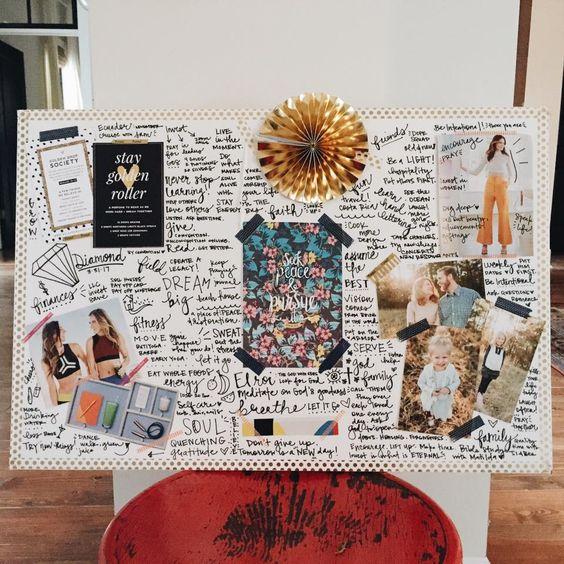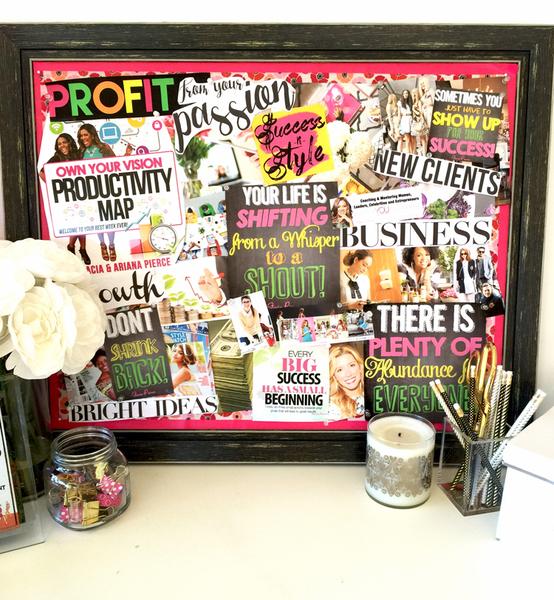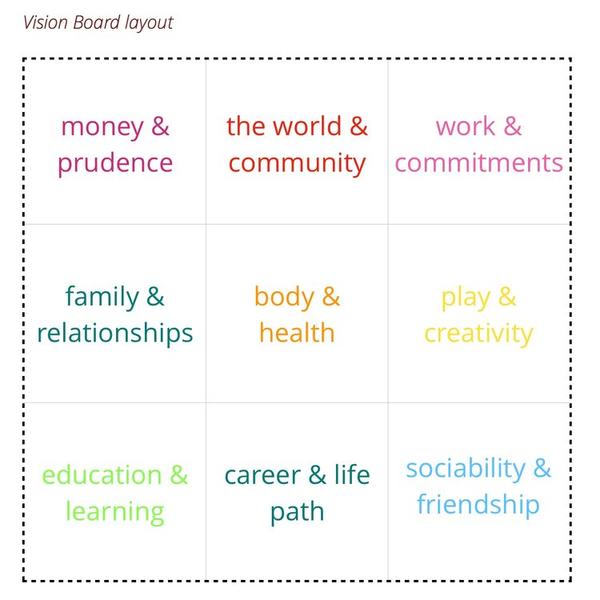 In 2016, Liz Funk was a New York-based freelance marketing consultant for early-stage startups. When she started feeling ready for a change—professionally, personally, and geographically—she created a vision board.
In 2016, Liz Funk was a New York-based freelance marketing consultant for early-stage startups. When she started feeling ready for a change—professionally, personally, and geographically—she created a vision board.
“I included brightly colored prints from a Lilly Pulitzer ad and the title of a Good Housekeeping article called ‘The Power of Awe,’” Funk says. “Fast forward two years, and I’m the founder of a subscription box company for secondhand clothes in like-new condition, we frequently re-sell Lilly Pulitzer clothes, and my company name, And We Evolve, can be abbreviated as ‘AWE.’”
A vision board, whether a physical poster or created virtually on a platform like Pinterest, can become an empowering tool for setting—and achieving—your New Year’s resolutions.
“Vision boarding is a fun and visual way to illustrate your company’s goals in a medium where you will see them every day,” says Funk. “It becomes an implicit, gentle reminder to do the things you said you wanted to do. I also find that when I’m having a challenging moment in my business, I can look at my vision boards and say, ‘Oh right, that’s the big picture.’ I feel my blood pressure go down.”
Goal-Setting Theory: Why Vision Boards Work

A disclaimer to the cynics who dismiss vision boarding as nothing more than a DIY craft project: There’s a scientific goal-setting theory behind this practice. Setting aside time to think deeply about your business goals for the year (and creating a vision board in the process) helps retailers meet basic goal-setting criteria and set themselves up for success. According to the Small Business Chronicle, these principles include:
- Clarity: Creating clear and measurable goals
- Challenging: This means no low-hanging fruit or goals that are easy to meet. Goals need to stretch you outside your comfort zone.
- Commitment: Entrepreneurs and employees need to be involved to actually follow through on a goal.
- Feedback: Incorporate a way to gather feedback, track progress, and offer recognition to employees successfully working toward a specific goal.
- Complexity: While a goal should be a challenge, it can’t be too overwhelming. Ensure you allot enough time and resources to actually achieve your goal.
Creating a vision board can help retailers work through this list and brainstorm a set of goals that will have the highest impact on your business.
Visualizing your goals also helps you achieve them. According to one study from TD Bank, one in five small business owners used a vision board (or a similar tool) when starting the business, and 76% reported that their business is now where they envisioned it would be when they started it.
“Visualization sparks flow—a psychological state associated with peak performance,” says Melody Wilding, a licensed master social worker and professor of human behavior at Hunter College in New York. “When you imagine the future and the goals you want to achieve, you activate a brain area that scans for new opportunities, called the reticular activating system. That’s why once you put something on your vision board, new opportunities start coming into your life: Because your brain is more actively looking for them.”
Think of vision boarding as a visual way of macro-level planning. As brand strategy consultant Kim Mackenzie puts it: “It’s like a captain before they jump on a ship: they need to plot their course.”
Vision boarding also helps you prioritize and gives you a clearer picture of your goals and what steps you need to take in order to achieve them.
Planning means you can take better control over where your energy and efforts go,” Mackenzie says.
If you’re ready to level up your goals this year, dream big and pin those dreams to a vision board—the ultimate manifestation tool.
8 Steps To Creating a Vision Board for Your Retail Business

Block Off Time, Block Out Distractions
When you’ve got revenue-generating tasks to complete, it’s easy to bump something like a vision board down your list of priorities. Build time into your calendar and treat your vision board time the way you’d treat an important meeting. Find a friend to create a vision board with and work in tandem to hold each other accountable.
If finding a few uninterrupted hours to commit to this task still seems impossible, make your vision board a weekend or after-hours activity.
Ask Yourself Some Questions
Mackenzie advises her clients to think about what their next year could look like before diving into their vision board. She suggests asking questions like, What feels right? What feels big? What does success look like?
“Success is personal and always shifting,” Mackenzie says. “One year it might be taking better care of yourself, another year it could be gaining 20% more clients. You should take some time to figure this out. When you know what you’re aiming for, it’s much easier to know what to say yes or no to.”
Some of the potential questions you can ask yourself to set goals and a vision for your retail business in 2019 include:
- What goals do you have for your business for the year? Think sales, marketing, growth, and beyond.
- How would you like to upgrade your own skills, both as a retailer and an employer? And how would you like to develop these skills?
- How would you like to invest in your business in 2019? That could include equipment, a new product collection, more staff, or any other investment of time or finances.
- How would you like to work with others in the industry this year? Do you want to do more networking to meet other retailers, build a partnership with a brand you admire or find a mentor to offer guidance?
- What other brands in your niche do you admire? What have they done well that you’d like to try in your business?
Divvy Up Your Goals
Funk divides her vision board ideas into four quadrants, each with a different goal. For example, one quadrant is labeled “Finance and Money,” and features the color green and words like “hundreds,” “millions,” and “trending upward.” Her other quadrants include “Growth and Goals” (pictures of her dream office and women speaking on conference panels), “Praise and Celebration of the Product” (photos of women in luxe clothes and a variety of positive adjectives), and “Girl Bosses and Inspirational Women” (pictures of female entrepreneurs like Tory Burch, Eileen Fisher, and Ellen Pao.)
I encourage people to think about the different areas of their ventures where they want to experience change, growth, or improvement, and come up with their own quadrants or sections.
“I think it’s helpful to group similar words and pictures, for the sake of having a cohesive organization and also for aesthetics,” she says.
Other common sections include “Play and Creativity,” “Education and Learning,” and “Sociability.” While many of the following sections are included in personal vision boards, several can be adapted for a business-focused board.

Source the Right Materials
Make sure you have the magazines, Pinterest images, and other materials best suited to finding the words, phrases, and pictures you’ll need for your vision board.
“You’ll probably want to have at least one trade publication so you can have photos specific to your industry,” says Funk. “I use Inc., Vanity Fair, and New York—those are good for general ambition, money, and success kinds of phrases. And, as a fashion entrepreneur, I use Vogue, and some fashion catalogs I receive.”
For a physical vision board, you’ll need materials like:
- Magazines, newspapers, pamphlets, or other printed materials
- Posterboard
- Markers
- Pens
- Colored pencils or crayons
- Paint
- Scissors or Exacto-knife
- Glue or other adhesive
For a digital vision board, use a tool like Pinterest or Canva to compile graphics, images, and other assets into a collage.
Keep Your Eyes Open To Inspiration
“Vision is the foundation to building anything worth value,” says Jasmine Takanikos, creator of the BrandHuman methodology and founder of branding and design studio Candor. “Start looking at the world differently—stay open and learn to document what moves you. Learn that design and user experience go hand in hand.”
Take the time to look up from your digital devices more often, especially while out of your home or office, and try to be more present.
Start Creating
Here’s where you start getting crafty.
“I usually make my vision boards on poster boards and use glue sticks to stick the images in place,” says Funk. “Next, I use a small foam brush, like one that you’d use for painting baseboards, and Mod Podge to really glue everything down and give the whole board a glossy, cohesive appearance.”
Once your board is complete, consider framing it or at least placing it in a prominent spot in your office or workspace. “You’re using your board to bring your wonderful and ambitious business goals to life,” says Funk, “So, why not?”
Go With the Flow
Don’t get hung up in the aesthetics of your vision board: Let go of rational thinking so your goals can flow.
“Worst-case scenario, you end up with a visually interesting collage,” Funk says. “Best case, you have a visual expression of your goals for your business on your wall that subconsciously seeps into your brain every time you walk by it.”
Remember that “done” is better than “perfect.” When it comes to vision boarding, you’re not being judged on your skills, so don’t overthink or obsess over technical details.
Consider Your Feelings Along With Your Goals
Don’t limit your images to physical objects—also think of the feelings they represent. “Don’t only focus on things you want to have or own,” Wilding says. “Focus on finding images that represent how you want to feel—the ideal emotions you want to experience.”
2019 New Year’s Resolutions: Vision Leads To Action
Create a vision board to help you achieve your 2019 New Year’s resolutions. It can help you maintain razor-sharp focus, avoid distractions, and force you to pinpoint your goals. It will also leave you with a visual reminder of those goals and hold you accountable to achieving them.

